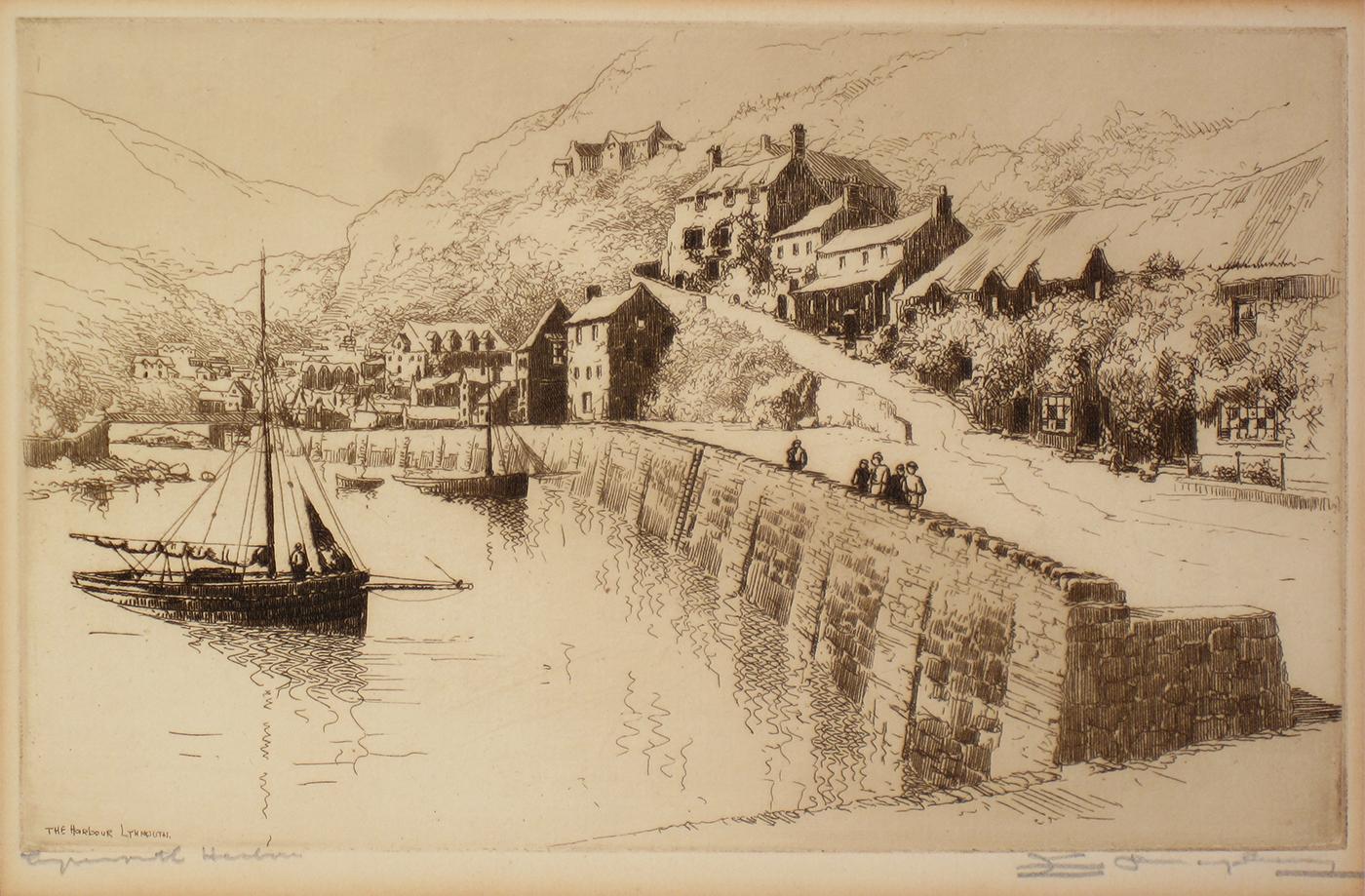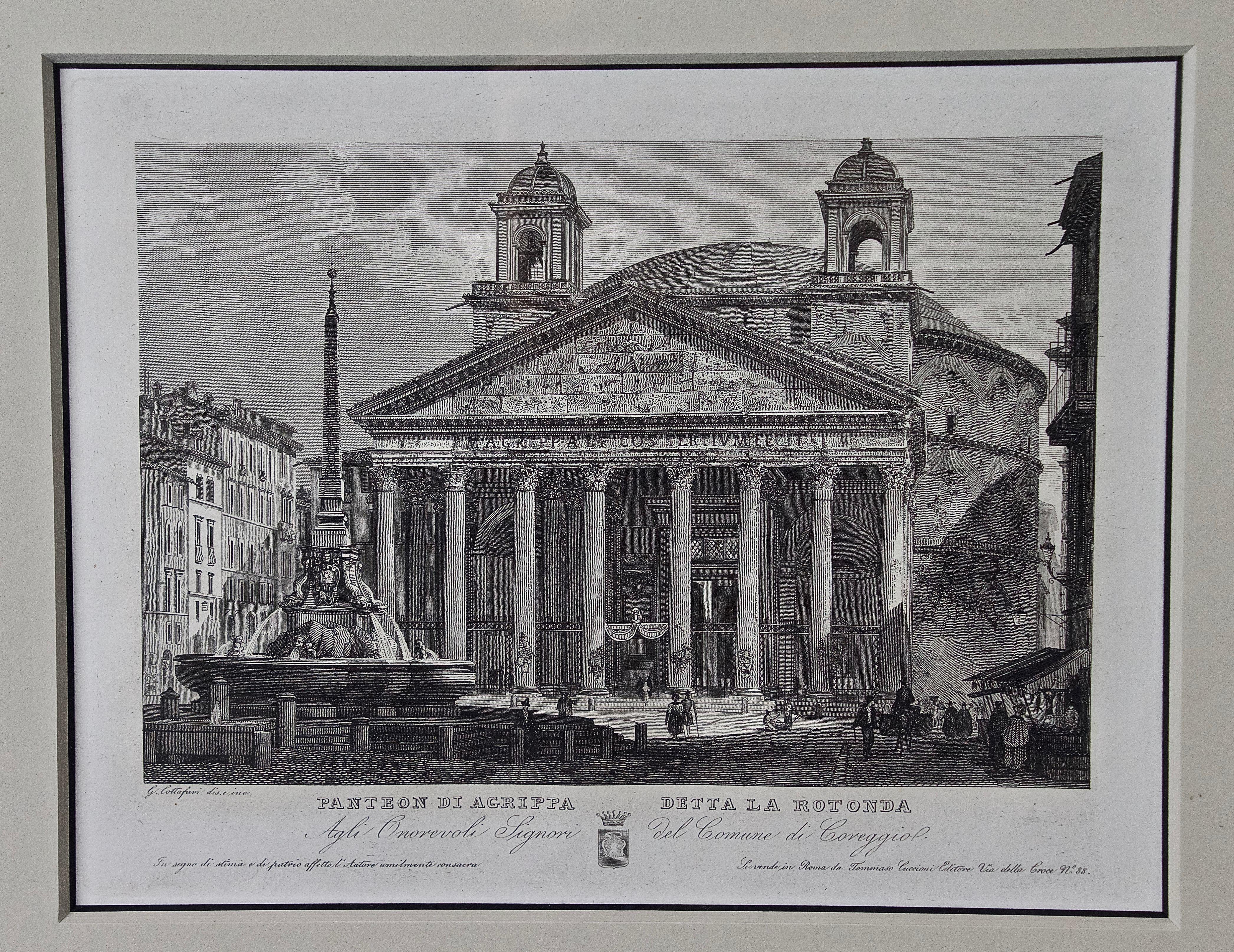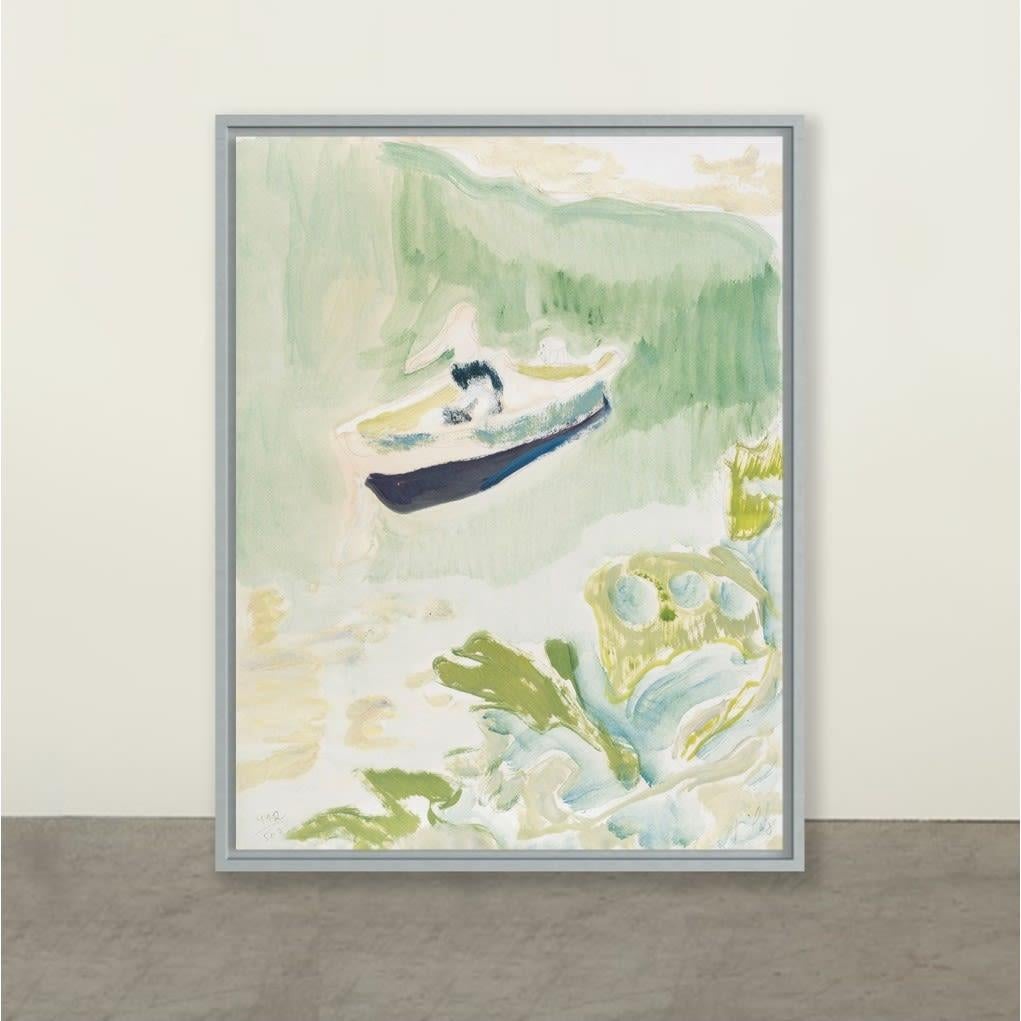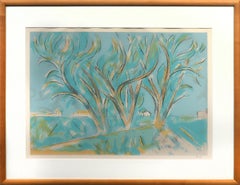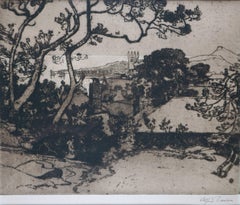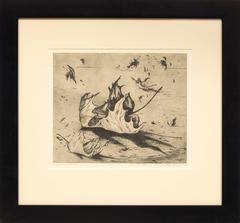
November Leaves, Artist Proof
View Similar Items
Want more images or videos?
Request additional images or videos from the seller
1 of 11
Ethel MagafanNovember Leaves, Artist Proofcirca 1947
circa 1947
About the Item
- Creator:Ethel Magafan (1916-1993, American)
- Creation Year:circa 1947
- Dimensions:Height: 20 in (50.8 cm)Width: 21.38 in (54.31 cm)Depth: 0.875 in (2.23 cm)
- Medium:
- Movement & Style:
- Period:
- Condition:
- Gallery Location:Denver, CO
- Reference Number:Seller: 120141stDibs: LU273112626
About the Seller
5.0
Platinum Seller
These expertly vetted sellers are 1stDibs' most experienced sellers and are rated highest by our customers.
Established in 1979
1stDibs seller since 2013
264 sales on 1stDibs
Typical response time: 5 hours
More From This SellerView All
- Comanche Dance, Ildefonso Pueblo, New Mexico Southwest Framed EtchingBy Gene KlossLocated in Denver, COComanche Dance at San Ildefonso Pueblo (New Mexico). Etching and drypoint, artist's proof from an edition of 50 prints. Presented in a custom frame, outer dimensions measure 22 ¼ x 18 ½ x ½ inches. Image size is 11 ¾ x 14 ½ inches. Print is clean and in very good vintage condition - please contact us for a detailed condition report. Expedited and international shipping is available - please contact us for a quote. About the Artist: Gene (Alice Geneva) Kloss is considered one of America’s master printmakers. She was born in Oakland, California and established herself as an artist on the West coast. Kloss was introduced to etching by Perham Nahl while at UC Berkley. She graduated in 1924, and in 1925 married poet Phillips Kloss. In her late twenties, Kloss moved to Taos, New Mexico and began her life’s work of the New Mexican landscape and peoples. It was at this time that she received national acclaim. Her artwork exudes an unmistakable content and style. Enchanted by the architecture, mountainous landscapes and rituals of the inhabitants, Kloss captured the beauty of the Southwest and surrounding areas. Her style was bold yet deftly simple, masterfully expressing the elusive Southwestern light...Category
1980s American Modern Figurative Prints
MaterialsDrypoint, Etching
$1,525 Sale Price53% Off - Trees in Ranchitos II, New Mexico, 1970s Color Lithograph Landscape with TreesBy Andrew Michael DasburgLocated in Denver, CO"Tree in Ranchitos II" (New Mexico) is a lithograph initialed lower right by artist Andrew Michael Dasburg (1887-1979) from 1975. Presented in a custom frame measuring 30 ½ x 36 ¼ inches. Image size is 16 ½ x 23 ¼ inches. About the Artist: Born France, 1887 Died New Mexico, 1979 Andrew Dasburg was born in Paris, but emigrated to New York City in 1892 with his mother. A childhood sickness left him lame, and his artistic propensities were first recognized by a teacher at the crippled children’s school. She enrolled him in the Art Students League in 1902. There he studied under Kenyon Cox, Frank Vincent Dumond, and Birge Harrison. Later, he began taking night classes from Robert Henri at the New York School of Art. Dasburg spent 1908-1910 in Paris, where he was introduced to the great impressionist painters Matisse and Cezanne. Inspired by the work of the European modernists, Dasburg returned to the United States, where he moved to Woodstock, New York. In Woodstock, he and his wife, Grace Mott Johnson, lived with Morgan Russell...Category
1970s American Modern Landscape Prints
MaterialsLithograph, Archival Paper
- Original Signed Lithograph Print of a Winter Landscape with Snow and TreesBy George Elbert BurrLocated in Denver, COOriginal signed lithograph print signed by George Elbert Burr (1859-1939) of a winter landscape with snow and trees. Presented in a custom frame with archival materials measuring 15 x 17 ¾ inches. Image size measures 7 ¼ x 10 ¼ inches. About the Artist: Born Ohio 1859 Died Arizona 1939 Ten years after his birth in Monroe Falls, Ohio, George Elbert Burr moved with his parents to Cameron, Missouri, where his father opened a hardware store. Burr was interested in art from an early age and his first etchings were created with the use of zinc scraps found in the spark pan under the kitchen stove. He then printed the plates on a press located in the tin shop of his father’s store. In December of 1878, Burr left for Illinois to attend the Art Institute of Chicago (then called the Chicago Academy of Design). By April of the following year, Burr had moved back to Missouri. The few months of study in Chicago constituted the only formal training the artist was to have. Back in Missouri, Burr heeded his family’s wishes by working in his father’s store. However, he did not abandon his art, often using his father’s railway pass to travel around the countryside on sketching trips. In 1894, Burr married Elizabeth Rogers and the following year he became an instructor for a local drawing class. By 1888, the artist was employed as an illustrator for Scribner’s, Harper’s, and The Observer. In 1892, Burr began a four-year project to illustrate a catalog for the Metropolitan Museum of Art of Heber R. Bishop’s jade collection. After completing approximately 1,000 etchings of the collection, Burr used the money he earned on the project to fund a trip abroad. The artist and his wife spent the years between 1896 and 1901 sketching and traveling on a tour of Europe that spanned from Sicily to North Wales. In 1906 the couple moved to Denver, Colorado, in an effort to improve George’s poor health. While in Colorado, Burr completed Mountain Moods, a series of 16 etchings. His years in Denver were highly productive despite his poor health. Burr’s winters were spent traveling through the deserts of Southern California, Arizona, and New Mexico. In 1921, Burr obtained copyrights on the last of 35 etchings included in his well-known Desert Set...Category
20th Century American Modern Landscape Prints
MaterialsLithograph
- House at Gregory Point (Colorado), 1930s Black and White Landscape LithographBy Arnold RönnebeckLocated in Denver, COOriginal Arnold Ronnebeck (1885-1947) lithograph of a home in Gregory Point, near Central City, Colorado from the 1930s. Edition of 25 printed. Presented in a custom frame, outer dimensions measure 23 ¼ x 18 ½ inches. Image size is 19 ¼ x 13 ¼ inches Print is clean and in very good vintage condition - please contact us for a detailed condition report. Provenance: Estate of Arnold Ronnebeck Expedited and international shipping is available - please contact us for a quote. About the Artist: Modernist sculptor, lithographer and museum administrator, Rönnebeck was a noted member of European and American avant-garde circles in the early twentieth century before settling in Denver, Colorado, in 1926. After studying architecture at the Royal Art School in Berlin for two years beginning in 1905, he moved to Paris in 1908 to study sculpture with Aristide Maillol and Émile-Antoine Bourdelle. While there he met and befriended American modernist painter, Marsden Hartley, of whom he sculpted a bronze head that was exhibited at the Salon d’Automne in Paris in 1912 and the following year at Hartley’s solo show of paintings at Alfred Stieglitz’s Gallery 291 in New York. A frequent guest of Gertrude Stein’s Saturday "evenings" in Paris, she described Rönnebeck as "charming and always invited to dinner," along with Pablo Picasso, Mabel Dodge (Luhan) and Charles Demuth. After the outbreak of World War I in 1914, Rönnebeck returned to Germany where he served as an officer in the German Imperial Army on the front lines. Twice wounded, including in the Battle of Marne in France, Kaiser Wilhelm II awarded him the Iron Cross. During the war Hartley fell in love with Rönnebeck’s cousin, Lieutenant Karl von Freyburg, who was killed in combat. As a tribute to Freyburg, Hartley created Portrait of a German Officer (1914) now in the Metropolitan Museum of Art in New York. After the war Rönnebeck traveled in Italy with German writer, Max Sidow, and German poet, Theodor Daubler, doing a series of drawings of Positano and the Amalfi Coast that formed the basis for his lithographs on the subject. The death of his finacée, the young American opera singer Alice Miriam in 1922 and his own family’s increasing financial problems in post-World War I Germany led him to immigrate to the United States in 1923. After living briefly with Miriam’s family in Washington, DC, he moved to New York where he became part of the avant-garde circle around Alfred Stieglitz. His essay, "Through the Eyes of a European Sculptor," appeared in the catalog for the Anderson Gallery exhibition, "Alfred Stieglitz Presents Seven Americans: 159 Paintings, Photographs & Things, Recent & Never Publicly Shown, by Arthur G. Dove, Marsden Hartley, John Marin, Charles Demuth, Paul Strand, Georgia O’Keeffe, Alfred Stieglitz." In New York Rönnebeck began producing Precisionist-style lithographs of the city’s urban landscapes which he termed "living cubism." Some of them were reproduced in Vanity Fair magazine. Through Stieglitz he met Erhard Weyhe head of the Weyhe Gallery who, with its director Carl Zigrosser, arranged Rönnebeck’s first solo American exhibition in May 1925 at the gallery in New York. Comprising some sixty works – prints, drawings and sculpture – the show subsequently traveled on a thirteen-month tour of major American cities. Until the end of his life, the gallery represented him, along with other American artists Adolf Dehn, Wanda Gag, Rockwell Kent, J.J. Lankes, Louis Lozowick, Reginald Marsh and John Sloan. In the summer of 1925, as the guest of Mabel Dodge Luhan, Rönnebeck first saw Taos, New Mexico, which Marsden Hartley had encouraged him to visit. It was there that he met his future wife, Louise Emerson, an easel painter and muralist. A year later they were married in New York before relocating to Denver. He served as director of the Denver Art Museum from 1926 to 1930 where he invited Marsden Hartley to lecture on Cézanne’s art in 1928. Rönnebeck fostered the development of the museum’s collection of American Indian art and the curation of modernist art exhibitions. In addition to his work at the museum, he was professor of sculpture at the University of Denver’s College of Fine and Applied Arts from 1929 to 1935, and wrote a weekly art column in the Rocky Mountain News. His best known Denver sculptures from the late 1920s in bronze, copper, stone, wood and terra cotta include a reredos, The Epiphany, at St. Martin’s Chapel; The History of Money (six panels) at the Denver National Bank; The Ascension at the Church of Ascension; and the William V. Hodges Family Memorial at Fairmount Cemetery. At the same time he did a series of terra cotta relief panels for La Fonda Hotel in Santa Fe, New Mexico. In the 1930s his bas-relief aluminum friezes of stylized Pueblo and Hopi Indian Kachina masks...Category
1930s American Modern Landscape Prints
MaterialsPaper, Lithograph
- Colorado Gold Dredge, Breckenridge, Signed Black and White Mining LithographBy Arnold RönnebeckLocated in Denver, COLithograph on paper titled 'Colorado Gold Dredge, Breckenridge' by Arnold Ronnebeck (1885-1947) from 1932. Numbered 15/25. Depicted is a gold dredge in Colorado mining town Breckenridge with a mountain landscape in the background. Presented in a custom frame measuring 17 ¼ x 21 ¼ inches. Image size measures 10 ¼ x 14 ¼ inches. Print is clean and in very good vintage condition - please contact us for a detailed condition report. Provenance: Estate of Arnold Ronnebeck Expedited and international shipping is available - please contact us for a quote. About the Artist: Modernist sculptor, lithographer and museum administrator, Rönnebeck was a noted member of European and American avant-garde circles in the early twentieth century before settling in Denver, Colorado, in 1926. After studying architecture at the Royal Art School in Berlin for two years beginning in 1905, he moved to Paris in 1908 to study sculpture with Aristide Maillol and Émile-Antoine Bourdelle. While there he met and befriended American modernist painter, Marsden Hartley, of whom he sculpted a bronze head that was exhibited at the Salon d’Automne in Paris in 1912 and the following year at Hartley’s solo show of paintings at Alfred Stieglitz’s Gallery 291 in New York. A frequent guest of Gertrude Stein’s Saturday "evenings" in Paris, she described Rönnebeck as "charming and always invited to dinner," along with Pablo Picasso, Mabel Dodge (Luhan) and Charles Demuth. After the outbreak of World War I in 1914, Rönnebeck returned to Germany where he served as an officer in the German Imperial Army on the front lines. Twice wounded, including in the Battle of Marne in France, Kaiser Wilhelm II awarded him the Iron Cross. During the war Hartley fell in love with Rönnebeck’s cousin, Lieutenant Karl von Freyburg, who was killed in combat. As a tribute to Freyburg, Hartley created Portrait of a German Officer (1914) now in the Metropolitan Museum of Art in New York. After the war Rönnebeck traveled in Italy with German writer, Max Sidow, and German poet, Theodor Daubler, doing a series of drawings of Positano and the Amalfi Coast that formed the basis for his lithographs on the subject. The death of his finacée, the young American opera singer Alice Miriam in 1922 and his own family’s increasing financial problems in post-World War I Germany led him to immigrate to the United States in 1923. After living briefly with Miriam’s family in Washington, DC, he moved to New York where he became part of the avant-garde circle around Alfred Stieglitz. His essay, "Through the Eyes of a European Sculptor," appeared in the catalog for the Anderson Gallery exhibition, "Alfred Stieglitz Presents Seven Americans: 159 Paintings, Photographs & Things, Recent & Never Publicly Shown, by Arthur G. Dove, Marsden Hartley, John Marin, Charles Demuth, Paul Strand, Georgia O’Keeffe, Alfred Stieglitz." In New York Rönnebeck began producing Precisionist-style lithographs of the city’s urban landscapes which he termed "living cubism." Some of them were reproduced in Vanity Fair magazine. Through Stieglitz he met Erhard Weyhe head of the Weyhe Gallery who, with its director Carl Zigrosser, arranged Rönnebeck’s first solo American exhibition in May 1925 at the gallery in New York. Comprising some sixty works – prints, drawings and sculpture – the show subsequently traveled on a thirteen-month tour of major American cities. Until the end of his life, the gallery represented him, along with other American artists Adolf Dehn, Wanda Gag, Rockwell Kent, J.J. Lankes, Louis Lozowick, Reginald Marsh and John Sloan. In the summer of 1925, as the guest of Mabel Dodge Luhan, Rönnebeck first saw Taos, New Mexico, which Marsden Hartley had encouraged him to visit. It was there that he met his future wife, Louise Emerson, an easel painter and muralist. A year later they were married in New York before relocating to Denver. He served as director of the Denver Art Museum from 1926 to 1930 where he invited Marsden Hartley to lecture on Cézanne’s art in 1928. Rönnebeck fostered the development of the museum’s collection of American Indian art and the curation of modernist art exhibitions. In addition to his work at the museum, he was professor of sculpture at the University of Denver’s College of Fine and Applied Arts from 1929 to 1935, and wrote a weekly art column in the Rocky Mountain News. His best known Denver sculptures from the late 1920s in bronze, copper, stone, wood and terra cotta include a reredos, The Epiphany, at St. Martin’s Chapel; The History of Money (six panels) at the Denver National Bank; The Ascension at the Church of Ascension; and the William V. Hodges Family Memorial at Fairmount Cemetery. At the same time he did a series of terra cotta relief panels for La Fonda Hotel in Santa Fe, New Mexico. In the 1930s his bas-relief aluminum friezes of stylized Pueblo and Hopi Indian Kachina masks...Category
1930s American Modern Landscape Prints
MaterialsPaper, Lithograph
- Silver Mine, Russell Gulch (12/25) Abstract Black and White Print in MountainsBy Arnold RönnebeckLocated in Denver, COLithograph on paper titled 'Silver Mine, Russell Gulch (12/25)' by Arnold Ronnebeck, which is a black and white lithograph print of an oil painting by him of the same name. It shows a mine with a mountain ridge in the background. Presented in a custom frame measuring 20 ½ x 26 ½ inches. Image size measures 10 ¼ x 14 ¼ inches. Print is clean and in very good vintage condition - please contact us for a detailed condition report. Provenance: Estate of Arnold Ronnebeck Expedited and international shipping is available - please contact us for a quote. About the Artist: Modernist sculptor, lithographer and museum administrator, Rönnebeck was a noted member of European and American avant-garde circles in the early twentieth century before settling in Denver, Colorado, in 1926. After studying architecture at the Royal Art School in Berlin for two years beginning in 1905, he moved to Paris in 1908 to study sculpture with Aristide Maillol and Émile-Antoine Bourdelle. While there he met and befriended American modernist painter, Marsden Hartley, of whom he sculpted a bronze head that was exhibited at the Salon d’Automne in Paris in 1912 and the following year at Hartley’s solo show of paintings at Alfred Stieglitz’s Gallery 291 in New York. A frequent guest of Gertrude Stein’s Saturday "evenings" in Paris, she described Rönnebeck as "charming and always invited to dinner," along with Pablo Picasso, Mabel Dodge (Luhan) and Charles Demuth. After the outbreak of World War I in 1914, Rönnebeck returned to Germany where he served as an officer in the German Imperial Army on the front lines. Twice wounded, including in the Battle of Marne in France, Kaiser Wilhelm II awarded him the Iron Cross. During the war Hartley fell in love with Rönnebeck’s cousin, Lieutenant Karl von Freyburg, who was killed in combat. As a tribute to Freyburg, Hartley created Portrait of a German Officer (1914) now in the Metropolitan Museum of Art in New York. After the war Rönnebeck traveled in Italy with German writer, Max Sidow, and German poet, Theodor Daubler, doing a series of drawings of Positano and the Amalfi Coast that formed the basis for his lithographs on the subject. The death of his finacée, the young American opera singer Alice Miriam in 1922 and his own family’s increasing financial problems in post-World War I Germany led him to immigrate to the United States in 1923. After living briefly with Miriam’s family in Washington, DC, he moved to New York where he became part of the avant-garde circle around Alfred Stieglitz. His essay, "Through the Eyes of a European Sculptor," appeared in the catalog for the Anderson Gallery exhibition, "Alfred Stieglitz Presents Seven Americans: 159 Paintings, Photographs & Things, Recent & Never Publicly Shown, by Arthur G. Dove, Marsden Hartley, John Marin, Charles Demuth, Paul Strand, Georgia O’Keeffe, Alfred Stieglitz." In New York Rönnebeck began producing Precisionist-style lithographs of the city’s urban landscapes which he termed "living cubism." Some of them were reproduced in Vanity Fair magazine. Through Stieglitz he met Erhard Weyhe head of the Weyhe Gallery who, with its director Carl Zigrosser, arranged Rönnebeck’s first solo American exhibition in May 1925 at the gallery in New York. Comprising some sixty works – prints, drawings and sculpture – the show subsequently traveled on a thirteen-month tour of major American cities. Until the end of his life, the gallery represented him, along with other American artists Adolf Dehn, Wanda Gag, Rockwell Kent, J.J. Lankes, Louis Lozowick, Reginald Marsh and John Sloan. In the summer of 1925, as the guest of Mabel Dodge Luhan, Rönnebeck first saw Taos, New Mexico, which Marsden Hartley had encouraged him to visit. It was there that he met his future wife, Louise Emerson, an easel painter and muralist. A year later they were married in New York before relocating to Denver. He served as director of the Denver Art Museum from 1926 to 1930 where he invited Marsden Hartley to lecture on Cézanne’s art in 1928. Rönnebeck fostered the development of the museum’s collection of American Indian art and the curation of modernist art exhibitions. In addition to his work at the museum, he was professor of sculpture at the University of Denver’s College of Fine and Applied Arts from 1929 to 1935, and wrote a weekly art column in the Rocky Mountain News. His best known Denver sculptures from the late 1920s in bronze, copper, stone, wood and terra cotta include a reredos, The Epiphany, at St. Martin’s Chapel; The History of Money (six panels) at the Denver National Bank; The Ascension at the Church of Ascension; and the William V. Hodges Family Memorial at Fairmount Cemetery. At the same time he did a series of terra cotta relief panels for La Fonda Hotel in Santa Fe, New Mexico. In the 1930s his bas-relief aluminum friezes of stylized Pueblo and Hopi Indian Kachina masks...Category
1930s American Modern Figurative Prints
MaterialsPaper, Lithograph
You May Also Like
- ShipwreckBy Robert StackhouseLocated in Milford, NHA fine etching titled “Shipwreck,” part of the Sources & Structures series of etchings by American artist Robert Stackhouse (b. 1942). Stackhouse was born in West Chester, PA, and ha...Category
1980s Realist Landscape Prints
MaterialsRag Paper, Etching
- The Harbour Lynmouth. Antique Print 1920sLocated in Sydney, NSWEdgar James Maybery The Harbour Lynmouth Antique Print 1920s Matt size 28cm x 33cm Image Size 14cm x 21 cmCategory
Early 20th Century Realist Landscape Prints
MaterialsEtching
- View of a coastal town / - The Pilgrim's View -Located in Berlin, DEAlbert Ernst (1909 Fronhofen - 1996 Hamburg), View of a Coastal Town, etching, 30 x 37 cm (picture), 45 x 50.5 cm (frame), signed in pencil lower right "Albert Ernst", framed under g...Category
Mid-20th Century Realist Landscape Prints
MaterialsEtching
$218 Sale Price20% Off - Evening - The depth of the visible -Located in Berlin, DEMax Clarenbach (1880 Neuss - Cologne 1952), Evening. Etching, 18 x 41 cm (platemark), 33.5 x 57 cm (frame), inscribed "Abend" in pencil at lower left, signed and dated "M. Clarenbach. 28.III.[19]09". Framed and mounted under glass. - Somewhat browned and slightly foxed. About the artwork The horizontally elongated etching depicts the panoramic view of a small town as seen from the other side of the river. There are gabled houses on the left and a mighty church spire on the right. The bourgeois houses and the large religious building indicate the urban character. These buildings are rendered in dark tones to emphasise the lighter row of houses in the centre of the picture, closer to the water. The chiaroscuro contrast creates two parallel planes that open up a space for the imagination of what the city could be. The imagination is stimulated by the almost entirely dark, barely recognisable buildings, while the arm of the river leading into the city further stimulates the imagination. However, as the silhouette of the city as a whole is reflected in the water, the parallel planes are perceived as a band of houses that stretches across the entire horizontality of the etching and seems to continue beyond the borders of the picture. The reflection has almost the same intensity as the houses themselves, so that the band of buildings merges with their reflection to form the dominant formal unit of the picture. Only the parallel horizontal hatching creates the convincing impression of seeing water, demonstrating Max Clarenbach's mastery of the etching needle. The water is completely motionless, the reflection unclouded by the slightest movement of the waves, creating a symmetry within the formal unity of the cityscape and its reflection that goes beyond the motif of a mere cityscape. A pictorial order is established that integrates everything in the picture and has a metaphysical character as a structure of order that transcends the individual things. This pictorial order is not only relevant in the pictorial world, but the picture itself reveals the order of the reality it depicts. Revealing the metaphysical order of reality in the structures of its visibility is what drives Clarenbach as an artist and motivates him to return to the same circle of motifs. The symmetry described is at the same time inherent an asymmetry that is a reflection on art: While the real cityscape is cut off at the top of the picture, two chimneys and above all the church tower are not visible, the reflection illustrates reality in its entirety. The reflection occupies a much larger space in the picture than reality itself. Since antiquity, art has been understood primarily as a reflection of reality, but here Clarenbach makes it clear that art is not a mere appearance, which can at best be a reflection of reality, but that art has the potential to reveal reality itself. The revealed structure of order is by no means purely formalistic; it appears at the same time as the mood of the landscape. The picture is filled with an almost sacred silence. Nothing in the picture evokes a sound, and there is complete stillness. There are no people in Clarenbach's landscape paintings to bring action into the picture. Not even we ourselves are assigned a viewing position in the picture, so that we do not become thematic subjects of action. Clarenbach also refrains from depicting technical achievements. The absence of man and technology creates an atmosphere of timelessness. Even if the specific date proves that Clarenbach is depicting something that happened before his eyes, without the date we would not be able to say which decade, or even which century, we are in. The motionless stillness, then, does not result in time being frozen in the picture, but rather in a timeless eternity that is nevertheless, as the title "Abend" (evening), added by Clarenbach himself, makes clear, a phenomenon of transition. The landscape of the stalls is about to be completely plunged into darkness, the buildings behind it only faintly discernible. The slightly darkened state of the sheet is in keeping with this transitional quality, which also lends the scene a sepia quality that underlines its timelessness. And yet the depiction is tied to a very specific time. Clarenbach dates the picture to the evening of 28 March 1909, which does not refer to the making of the etching, but to the capture of the landscape's essence in the landscape itself. If the real landscape is thus in a state of transition, and therefore something ephemeral, art reveals its true nature in that reality, subject to the flow of phenomena, is transferred to an eternal moment, subject to a supra-temporal structure of order - revealed by art. Despite this supratemporality, the picture also shows the harbingers of night as the coming darkening of the world, which gives the picture a deeply melancholy quality, enhanced by the browning of the leaf. It is the philosophical content and the lyrical-melancholic effect of the graphic that give it its enchanting power. Once we are immersed in the image, it literally takes a jerk to disengage from it. This etching, so characteristic of Max Clarenbach's art, is - not least because of its dimensions - a major work in his graphic oeuvre. About the artist Born into poverty and orphaned at an early age, the artistically gifted young Max Clarenbach was discovered by Andreas Achenbach and admitted to the Düsseldorf Art Academy at the age of 13. "Completely penniless, I worked for an uncle in a cardboard factory in the evenings to pay for my studies.” - Max Clarenbach At the academy he studied under Arthur Kampf, among others, and in 1897 was accepted into Eugen Dücker...Category
Early 1900s Realist Landscape Prints
MaterialsEtching
- The Thames, 1894 - Victorian aquatint etching of London by Joseph PennellBy Joseph PennellLocated in London, GBJOSEPH PENNELL (1857-1926) The Thames, 1894 Signed Aquatint Plate size 20.5 by 26.5 cm., 8 by 10 ½ in. (frame size 42 by 46 cm., 16 ½ by 18 in.) Pennell was born in Philadelphia where he studied at School of Industrial Art and the Academy of Fine Arts. In 1884 he was commissioned by the Century Magazine to supply a series of drawings of London...Category
1890s Realist Landscape Prints
MaterialsAquatint
- The Pantheon in Rome: A 19th Century Etching by CottafaviLocated in Alamo, CAThis is a 19th century architectural etching of the Pantheon in Rome entitled "Panteon di Agrippa detta La Rotonda", plate 9 from "Raccolta delle principali vedute di Roma e...Category
Mid-19th Century Realist Landscape Prints
MaterialsEtching
Recently Viewed
View AllMore Ways To Browse
Light Blue Platforms
Braun Artist
Lino Cut Prints
Exotic Jungle
Vintage Foliage Prints
Cathedral Train
Antique Sailing Prints
Tiffanys California
Andrew Wyeth Print
Black And White Wood Block Print
Sea Captains Portraits
Us Coast Guard
Skiing Lithographs
Mulberry Home
Ski Lithograph
Lewis Martin
Martin And Lewis
Green Woodblock Print
